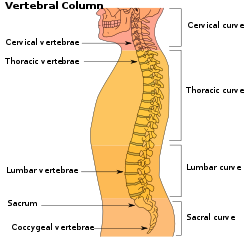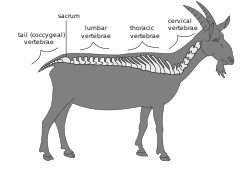
Back Werwelkolom Afrikaans Wirbelsäule ALS ደንደስ Amharic Columna vertebral AN عمود فقري Arabic ܥܡܘܕܐ ܦܩܪܝܐ ARC Columna vertebral AST Ototokwakan ATJ Мугъзагьод AV Jikhani k'ili Aymara
| Vertebral column | |
|---|---|
 The human vertebral column and its regions | |
 Vertebral column of a goat | |
| Details | |
| Identifiers | |
| Latin | columna vertebralis |
| Anatomical terminology | |
The vertebral column, also known as the spinal column, spine or backbone, is the core part of the axial skeleton in vertebrate animals. The vertebral column is the defining and eponymous characteristic of the vertebrate endoskeleton, where the notochord (an elastic collagen-wrapped glycoprotein rod) found in all chordates has been replaced by a segmented series of mineralized irregular bones (or sometimes, cartilages) called vertebrae, separated by fibrocartilaginous intervertebral discs (the center of which is a notochord remnant).[1] The dorsal portion of the vertebral column houses the spinal canal, an elongated cavity formed by alignment of the vertebral neural arches that encloses and protects the spinal cord, with spinal nerves exiting via the intervertebral foramina to innervate each body segments.
There are around 50,000 species of animals that have a vertebral column.[2] The human spine is one of the most-studied examples, as the general structure of human vertebrae is fairly typical (homologous) of that found in other mammals, reptiles and birds. The shape of the vertebral body does, however, vary somewhat between different groups of living species.
Individual vertebrae are named according to their corresponding body region (neck, thorax, abdomen, pelvis or tail). In clinical medicine, features on vertebrae (particularly the spinous process) can be used as surface landmarks to guide medical procedures such as lumbar punctures and spinal anesthesia. There are also many different spinal diseases in humans that can affect both the bony vertebrae and the intervertebral discs, with kyphosis/scoliosis, ankylosing spondylitis, degenerative discs and spina bifida being recognizable examples.
- ^ Liem KF, Walker WF (2001). Functional anatomy of the vertebrates: an evolutionary perspective. Harcourt College Publishers. p. 277. ISBN 978-0-03-022369-3.
- ^ Krogh D (2010). Biology: A Guide to the Natural World. Benjamin-Cummings Publishing Company. p. 333. ISBN 978-0-321-61655-5. Archived from the original on 2023-01-24. Retrieved 2015-06-27.
© MMXXIII Rich X Search. We shall prevail. All rights reserved. Rich X Search